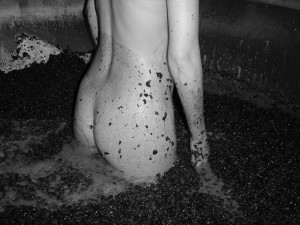 In the last five days of 2010, we are going to count down five of our favorite stories from some of our favorite authors in our first year. Today’s edition, The Sensual Side of Pinot Noir, by Kerry Newberry, continues to draw new views, even a year after it was published. This is a beautifully written story that lets the reader feel the wine and the grapes, even with their clothes on. This story, and all the stories featured in our last week, can be found in The Best of the Press, Volume I, available in print or as an eBook for all platforms.
In the last five days of 2010, we are going to count down five of our favorite stories from some of our favorite authors in our first year. Today’s edition, The Sensual Side of Pinot Noir, by Kerry Newberry, continues to draw new views, even a year after it was published. This is a beautifully written story that lets the reader feel the wine and the grapes, even with their clothes on. This story, and all the stories featured in our last week, can be found in The Best of the Press, Volume I, available in print or as an eBook for all platforms.
The Sensual Side of Pinot Noir, by Kerry Newberry
I love Pinot Noir. And I don’t toss this word about flippantly. Our relationship blossomed in graduate school: late star-lit nights, candles burning by my laptop, a pile of books and a split of Pinot Noir.
Last October I shared my passion for Oregon’s noble varietal with a friend visiting from Santa Fe. Memories of our vineyard escapade still linger. It was a moment of true serendipity, our Xanadu transpired. As we cruised up to my favorite winery, the harvest crew bustled about with hoses, buckets and brooms, multi-tasking with ease.
The winemaker welcomed us into his rustic winery with a call: “You are just on time, I have a vat needing pigeage in about five minutes.”
“Pigeage?” queried my friend. The winemaker, busy measuring things unknown to us but surely important, continued: “Yes, when fermenting red wine, the grape juice, skins, seeds and sometimes stems are placed in a fermentation tank. Sugar is transformed into alcohol and carbon dioxide, creating heat…it’s about 90 degrees in that tank right now.”
During this lusty fermentation process, the grape juice settles into the lower part of the tanks while the grape skins and solids are pushed to the surface by tiny bubbles of carbon dioxide. This top section is known as the “cap” or le chapeau. If left there, the skins and solids dry out. They must be kept moist to extract the color and tannins from the skins of the Pinot Noir grapes. This French craft of pigeage or literally “punch-down” is done up to three times a day. This also ensures each grape bursts during alcoholic fermentation, enhancing the flavor and character of the wine. “So are you up for it?” he smiled.
“Yes!” I replied. We still had no idea what we were facing at this point, but in some direct or indirect way it involved wine so I was game. Santa Fe (as we will call her at this point) was not so ready to consent. “What are we doing again?” she laughed. “Pigeage,” chorused the winemaker and I. She turned to me with a quizzical look, “Do you know what that is?”
“No,” I whispered in response. “But let’s do it, life is short!” And I feared the offer might be revoked if we didn’t accept and pigeage in a timely manner. The beckoning, sensuous grapes were on a tight fermenting schedule. We went downstairs, still not believing our task at hand. Pigeage is performed with all red wines, but this technique hails from old world Burgundy. Tradition trumps technology. We found the tank in need—round, inviting and more than spacious enough for two. Ecstatic, yet hesitant, we quickly shed our autumn attire, tip-toed up a wooden step ladder and climbed into the voluminous vat of grapes.
 An infinity of quietly, burbling deep purple engulfed our senses and Pablo Neruda’s Ode to Wine came to mind: “wine, smooth…soft as lascivious velvet, wine, spiraled-sea shelled and full of wonder, amorous, marine.”
An infinity of quietly, burbling deep purple engulfed our senses and Pablo Neruda’s Ode to Wine came to mind: “wine, smooth…soft as lascivious velvet, wine, spiraled-sea shelled and full of wonder, amorous, marine.”
Potent and provocative, the scent of fermenting grapes saturated the air. Every step forward through the must of warm, soft, Pinot Noir grape clusters felt like trying to move quickly through a swimming pool with leg weights on. The cap was heavy and hard to stir. Yet we persevered, mixing the juice and cap to extract maximum color, flavor and tannin.
Time seemed to stand still as we absorbed this primal adventure in a quixotic winery. We whispered as we tread, like we were in the Sistine Chapel for winemaking. With each circle of the tank, the more fluid the viscous grape concoction became. An enduring tradition, some winemakers find the practice of physical pigeage a more delicate process than an indifferent machine. “I think we’ve pigeaged this really well,” I confided to Santa Fe with sincerity. After fifteen or so minutes passed we wondered how long were we supposed to stay. Should we stay in, or climb out of the epicurean vessel?
We exited eventually, and climbed slowly from the grapes into the brisk afternoon air. Our legs were now stained a deep magenta. Juice cascaded from the lingering grape skins in rivulets, our body and senses were tingling and alive.
—Kerry Newberry is a freelance writer in Portland, Oregon. She covers food, wine and farms for a variety of national and regional publications. Her love affair with Pinot grows with each fermentation tank she encounters. www.kerrynewberry.com

